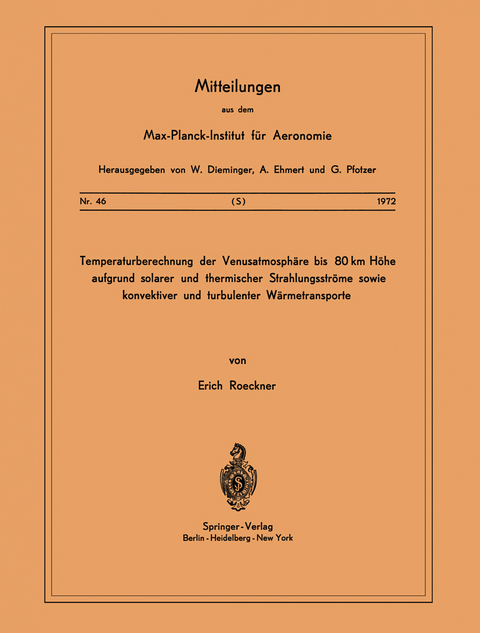Temperaturberechnung der Venusatmosphäre bis 80 km Höhe aufgrund Solarer und Thermischer Strahlungsströme Sowie Konvektiver und Turbulenter Wärmetransporte
Springer Berlin (Verlag)
978-3-540-05776-5 (ISBN)
und Problemstellung.- Fakten und Voraussetzungen.- 2.1 Elemente der Umlaufbahn, Rotation und Dimension des Planeten Venus.- 2.2 Zusammensetzung der Atmosphäre.- 2.3 Wolken.- 2.4 Temperatur und Druck an der Oberfläche.- 2.5 Voraussetzungen.- Theorie.- 3.1 Strahlungsströme.- 3.2 Wärmetransport.- Absorptionsfunktionen.- 4.1 Absorptionsspektren von Kohlendioxid und Wasserdampf.- 4.2 Absorptionsmodelle.- 4.3 Auswertung der Absorptionsdaten.- 4.4 Berechnung der Absorptionsfunktionen.- 4.5 Temperatur- und Druckkorrektur.- 4.6 Absorption von Gasgemischen.- 4.7 Interpolations - und Extrapolationsverfahren.- Modell und Methode.- 5.1 Modell.- 5.2 Anfangsbedingungen.- 5.3 Randbedingungen.- 5.4 Rechenmethode.- Fehlerbetrachtung.- Ergebnisse.- 7.1 Wasserdampfgehalt.- 7.2 Wolken.- 7.3 Bodendruck, Diffusionskoeffizient, Albedo, Randbedingungen.- 7.4 Meridionale und tageszeitliche Temperaturunterschiede.- Vergleich mit anderen Ergebnissen.- Allgemeine Zirkulation der Venusatmosphäre.- Zusammenfassung.- Summary.- Symbole und Abkürzungen.
| Erscheint lt. Verlag | 24.2.1972 |
|---|---|
| Reihe/Serie | Mitteilungen aus dem Max-Planck-Institut für Aeronomie |
| Zusatzinfo | 58 S. |
| Verlagsort | Berlin |
| Sprache | deutsch |
| Maße | 210 x 279 mm |
| Gewicht | 190 g |
| Themenwelt | Naturwissenschaften ► Physik / Astronomie ► Allgemeines / Lexika |
| Schlagworte | Diffusion • Energie • Strahlung • Wärme • Wellen |
| ISBN-10 | 3-540-05776-5 / 3540057765 |
| ISBN-13 | 978-3-540-05776-5 / 9783540057765 |
| Zustand | Neuware |
| Haben Sie eine Frage zum Produkt? |
aus dem Bereich




